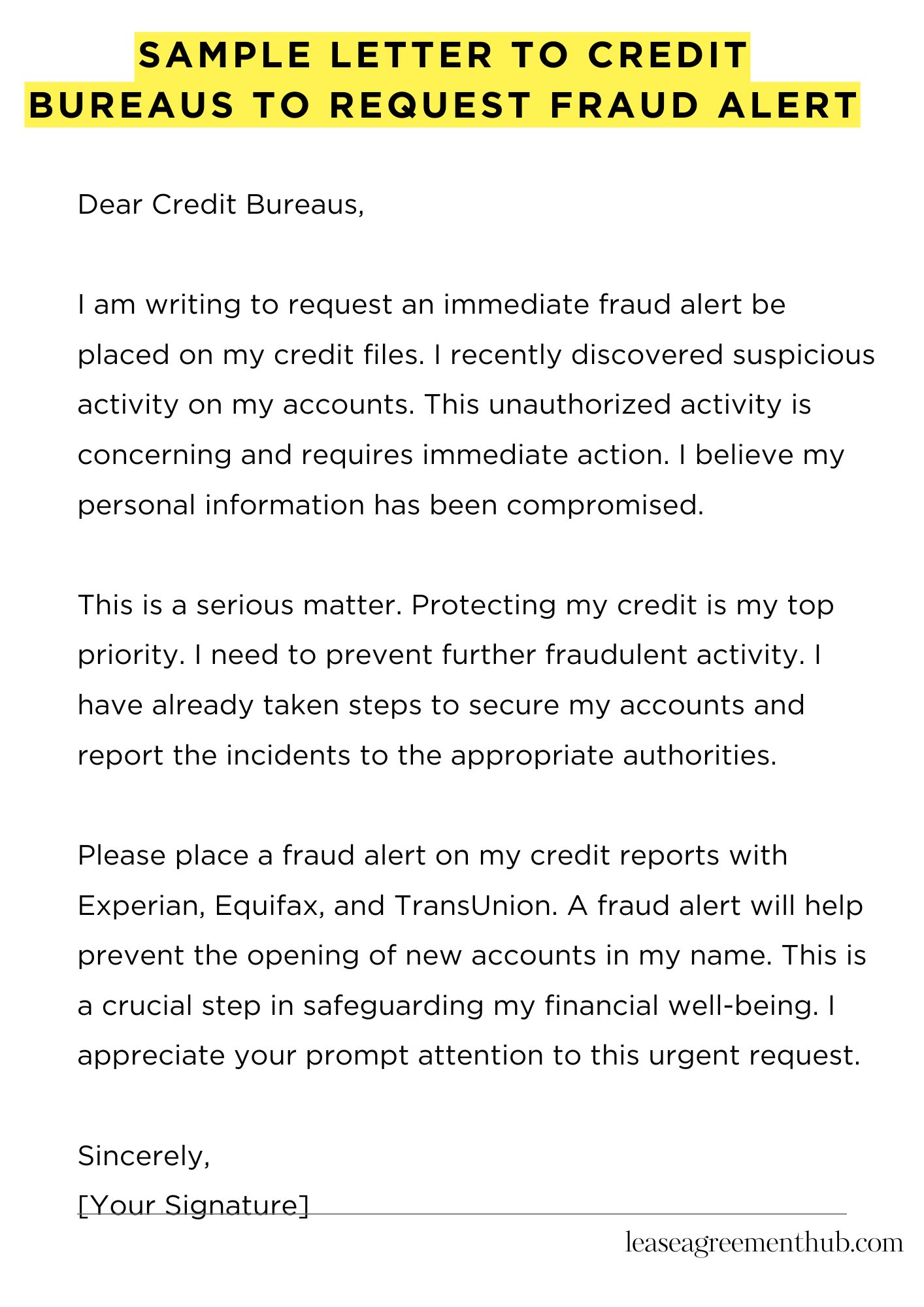A fraud alert protects your credit. It tells credit bureaus to verify your identity before issuing new credit. This prevents fraudsters from opening accounts in your name.
This article gives you sample letters. These are templates. They make writing your own letter easy. You can adapt them to your situation.
Use these samples to quickly write your letter. Protect yourself from identity theft. Get started now.
Sample Letter to Credit Bureaus to Request Fraud Alert
[Your Name]
[Your Address]
[Your Phone Number]
[Your Email Address]
[Date]
Experian
P.O. Box 9554
Allen, TX 75013
Equifax
P.O. Box 740126
Atlanta, GA 30374-0126
TransUnion
P.O. Box 2000
Chester, PA 19016
Subject: Fraud Alert Request
Dear Credit Bureaus,
I am writing to request an immediate fraud alert be placed on my credit files. I recently discovered suspicious activity on my accounts. This unauthorized activity is concerning and requires immediate action. I believe my personal information has been compromised.
This is a serious matter. Protecting my credit is my top priority. I need to prevent further fraudulent activity. I have already taken steps to secure my accounts and report the incidents to the appropriate authorities.
Please place a fraud alert on my credit reports with Experian, Equifax, and TransUnion. A fraud alert will help prevent the opening of new accounts in my name. This is a crucial step in safeguarding my financial well-being. I appreciate your prompt attention to this urgent request.
Sincerely,
[Your Signature]

How to Write a Sample Letter to Credit Bureaus to Request a Fraud Alert
Understanding the Gravity of the Situation
Discovering fraudulent activity on your credit report is a serious matter, demanding immediate and decisive action. Procrastination is inimical to your financial well-being. Promptly contacting the credit bureaus is paramount. This isn’t simply about a minor inconvenience; it’s about safeguarding your financial future. A timely response can mitigate significant long-term damage.
Identifying the Culprits: Pinpointing Fraudulent Activity
Before you even begin drafting your letter, meticulously examine your credit reports from Equifax, Experian, and TransUnion. Identify each and every instance of suspicious activity. Note the specific accounts compromised, the dates of the fraudulent transactions, and any other pertinent details. This meticulous documentation will bolster your claim and expedite the process. The more evidence you provide, the more effective your communication will be.
Crafting Your Missive: Key Elements of an Effective Letter
Your letter should be concise yet comprehensive. Begin with a formal salutation, addressing each bureau individually. Clearly state your intention to request a fraud alert. Then, present a succinct yet detailed account of the fraudulent activity you’ve discovered. Include all relevant dates, account numbers, and amounts involved. Accuracy is sacrosanct. Any obfuscation or vagueness could impede the resolution of your issue.
The Anatomy of a Persuasive Argument: Structuring Your Letter
Organize your letter logically. Lead with a brief overview of the situation. Follow with a chronological account of the fraudulent events. Conclude with a clear and unambiguous request for a fraud alert to be placed on your credit file. Your narrative should be clear, concise, and easily digestible. Avoid jargon and unnecessary embellishments; clarity trumps eloquence in this context.
Essential Information: What to Include in Your Letter
Besides the details of the fraudulent activity, your letter should include your full name, current address, phone number, Social Security number, and any relevant account numbers. This information is crucial for verification and processing your request efficiently. Remember, providing accurate and complete information is essential for a swift and effective resolution.
Sending Your Letter: Methods and Considerations
Certified mail with return receipt requested is the preferred method of sending your letter. This provides irrefutable proof of delivery and ensures your communication reaches its intended recipient. Consider sending the letter via email as a secondary measure, but always prioritize the certified mail option for maximum efficacy. A copy of the letter should be retained for your records.
Following Up: Ensuring Action is Taken
After sending your letters, follow up with a phone call to each credit bureau to confirm receipt and the status of your request. Persistence is key. Don’t hesitate to contact them repeatedly until you receive confirmation that the fraud alert has been activated. This diligent follow-up demonstrates your commitment and ensures a timely resolution to your predicament.
FAQs about sample letter to credit bureaus to request fraud alert
What information should I include in my letter to request a fraud alert?
Your letter should include your full name, current address, phone number, Social Security number, a clear statement requesting a fraud alert be placed on your credit file, and a brief explanation of why you’re requesting the alert (e.g., suspected identity theft, lost or stolen wallet).
Which credit bureaus should I send my letter to?
You should send your letter to all three major credit bureaus: Equifax, Experian, and TransUnion. Each bureau maintains its own separate credit file.
What is the best way to send my letter to the credit bureaus?
Certified mail with return receipt requested provides proof of delivery. Alternatively, you can send the letter via email if the credit bureau’s website allows it; however, certified mail offers greater security.
How long does it take for a fraud alert to be placed on my credit file?
The timeframe varies, but generally, a fraud alert is implemented within 24 to 48 hours of receiving your request. However, it’s advisable to allow a few business days for processing.
What are the benefits of placing a fraud alert on my credit file?
A fraud alert notifies creditors that you may be a victim of identity theft, prompting them to take extra steps to verify your identity before granting credit. This significantly reduces the risk of fraudulent accounts being opened in your name.
Related: